Ramen, Beans, and Potatoes, Oh My!
Post Metadata
Unparalleled work-life balance, frequent travel to exotic locales for conferences, and plentiful free food.
These are some of the few reasons that would entice anyone in their right mind to choose grad school over a cushy life with a real job; filled with wifi-enabled corporate shuttles, quarterly KPIs and OKRs, and your very own access card with a special colour border letting everyone else know how long you’ve been disagreeing and committing while driving value to shareholders.
In fact, they’re the only reasons I chose to pursue a graduate education.
And, for a while, all was well.
A Time of Plenty
Ask any Allen School student about their favourite channels on our Slack
instance and you’re bound to get a wide range of answers.
Are they a fiend for a good deal?
Do they amass a collection of free items that they promise they’ll really use?
Yes, they really want (and need!) 15 cardboard boxes.
They probably watch #free-or-cheap-stuff like a hawk.
Or maybe they’re into running,
that so-called “sport” where millions convince themselves that they actually
enjoy laboured breathing for hours on end,
crawling up what could only be described as a minor incline while screaming
“the hills pay the bills!”
#raceconditionrunning is likely pinned
to their sidebar.
If they like nothing better than crushing their friends in games where
explaining the rules takes longer than playing an actual round,
you’ll likely find them lurking in #boardgames.
One thing is certain,
though,
for any Allen School student.
They probably monitor the #food channel for any free food they can scrounge
up.
The #food channel is a place where leftover food is proffered for posterity,
where “lightly expired snacks”,
platters of wraps,
oceans of parmesan,
butter chicken,
naan,
and trays of rice find new life.
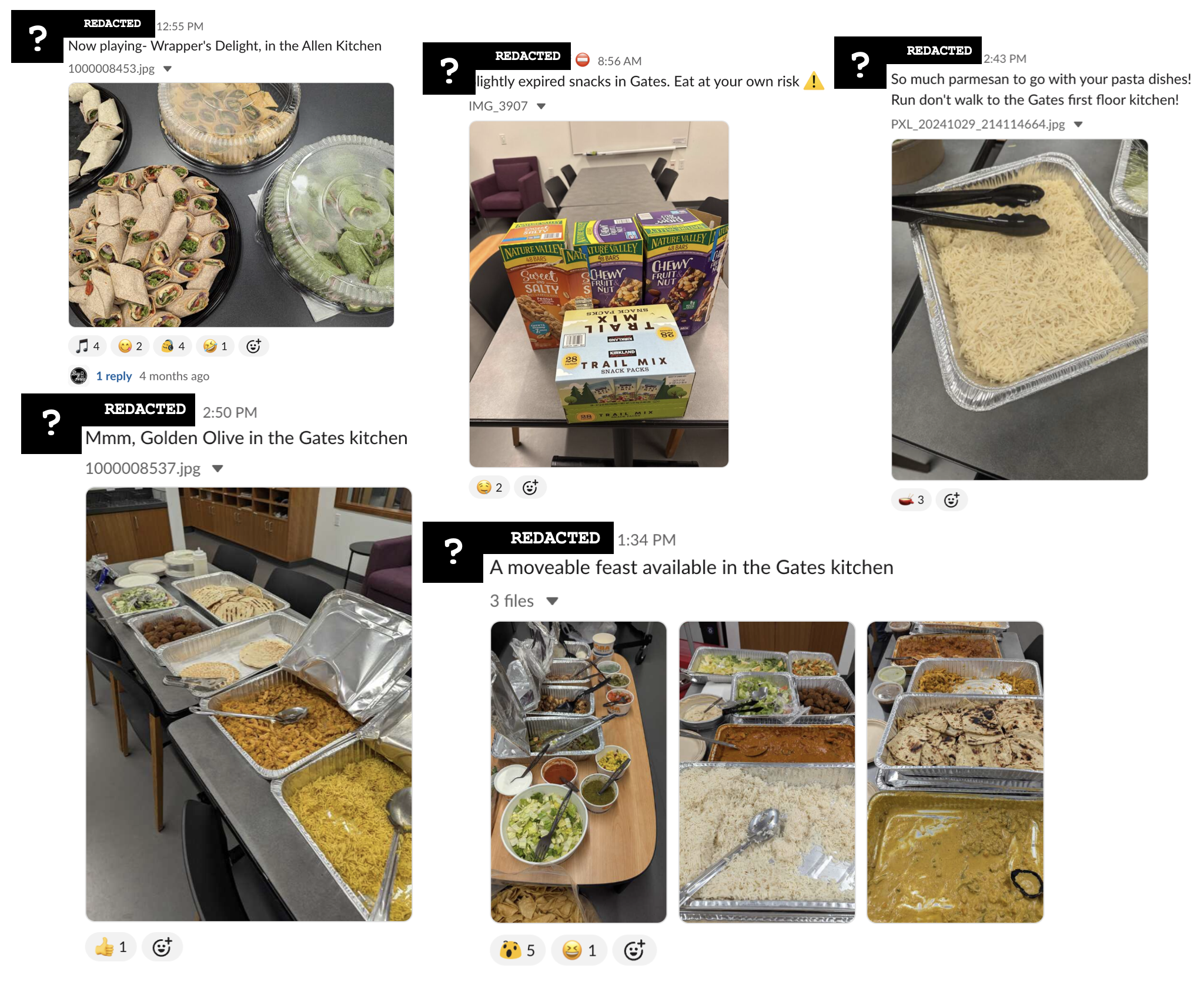
Legend even tells of grad students who attain the perfect week;
an entire week subsisting solely on what they masterfully scavenge from
#food,
a herculean task requiring eyes like a hawk and hair-trigger reflexes.
Black Swan Event
8:42am, Thursday March 13, 2025–a date which will live in infamy. With one email (the irrelevant contents of which have been tastefully redacted), the worst fear of an Allen School PhD student was realized:
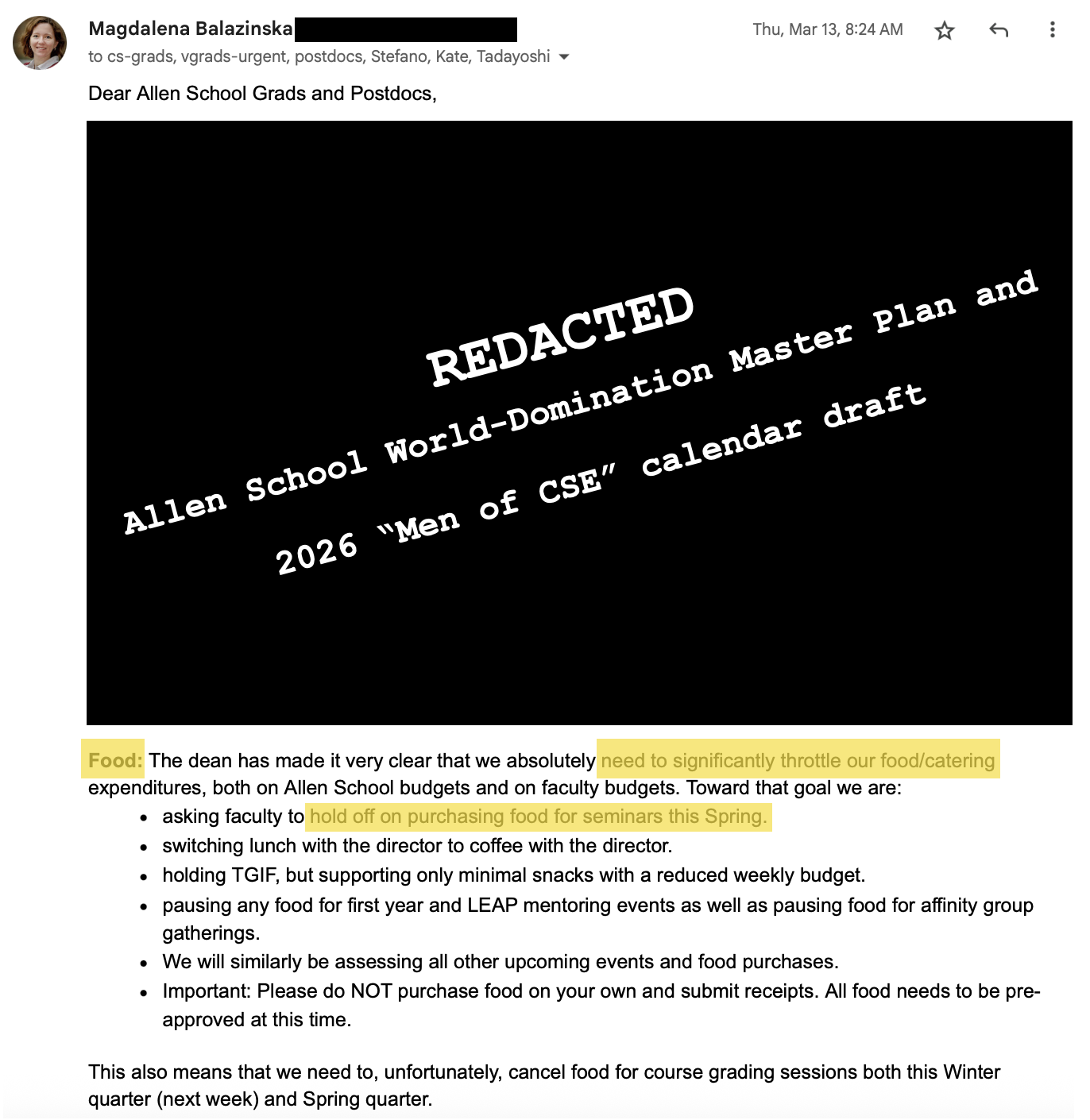
We knew the world would not be the same, a few people laughed, a few people cried. Most people were silent. I knew I was safe, at least for a while, with my strategic carbohydrate reserve (SCR)1. But this would mean the end of food at PLSE lunch for a while. The rivers of butter chicken and Thai curry ran dry. The platters of white rice, begging to be drowned in a communal container of Lao Gan Ma, became nothing but a distant memory.
My strategic carbohydrate reserve was completely depleted during the first PLSE lunch without free food.
Any normal (i.e., sane) research group would have gawked at this mild inconvenience and moved on. But we’re doers at PLSE, and we do things not because they are easy, but because we thought they would be easy. And how hard could it be to prepare lunch for a lab full of hungry, sleep-deprived grad students every week? What do grad students even eat, ramen?
PLSE Austerity Lunches
We were taken by complete surprise for the first PLSE lunch after Magda’s email; we had hoped (and assumed!) that previously-submitted food orders would be fulfilled. Hungry grad students came to the lab, hoping for one last hurrah of free food. But alas, this wasn’t the case, and reality quickly set in.
But this was the moment I’d been waiting for. I deployed my strategic carbohydrate reserve of sweet potatoes.
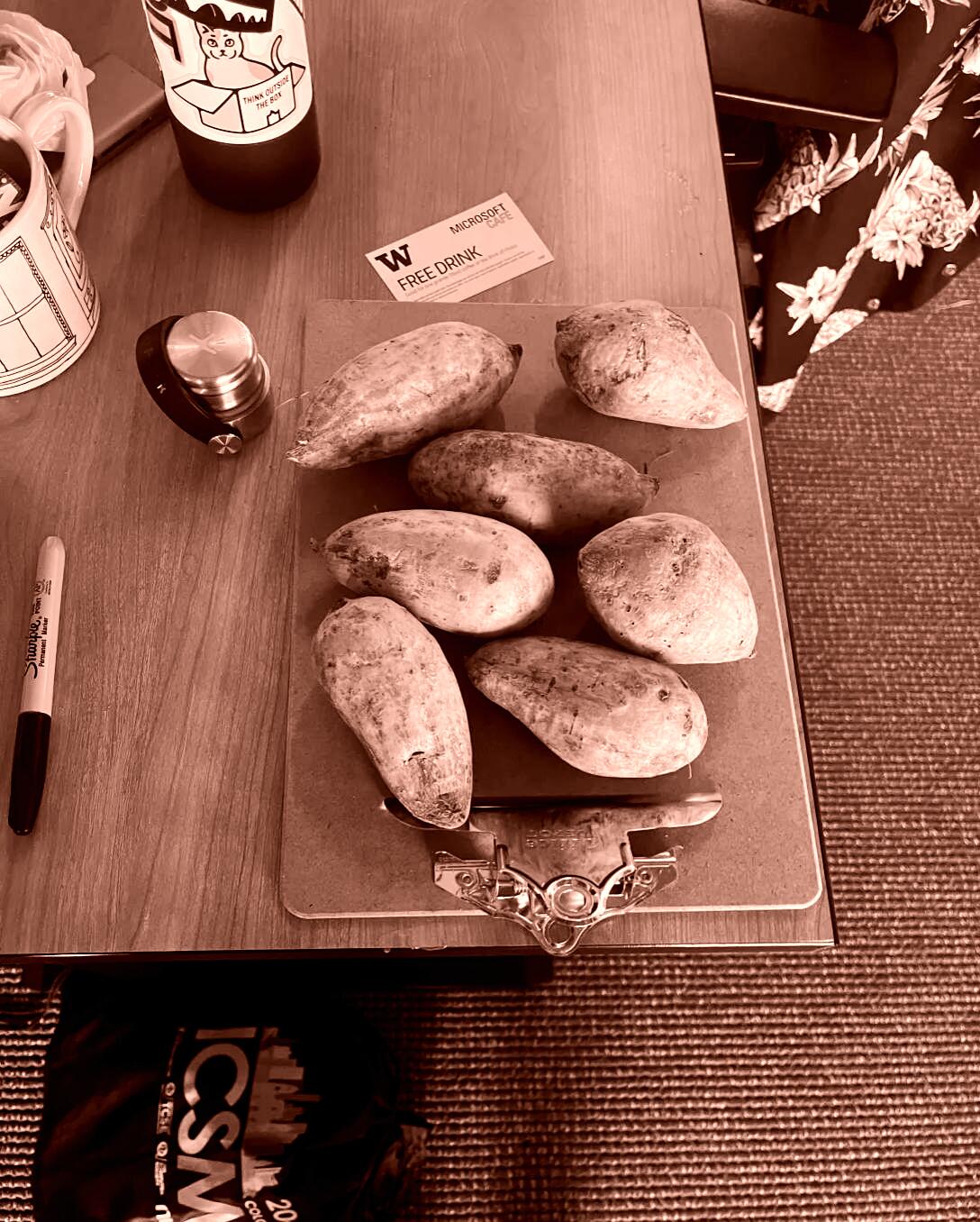
You might ask: have things gotten so desperate so quickly that we just ate raw sweet potatoes? No, of course not. We have standards. A raw sweet potato can be converted into an infinitely-palatable foodstuff in mere minutes via microwave, just remember to poke a few holes in them to prevent a steam explosion! They were gone surprisingly fast.
Now, I would have been satisfied with having potatoes at PLSE lunch for the rest of the quarter, but some of my lab members (who have higher standards for food than I do) had other ideas in mind.
Thus began the saga of PLSE Austerity Lunches.
Week 0: Pizza
Ingredients
- (1x) Michael Ernst
- As many 18in Costco pizzas as your group desires
- A tin of homemade chocolate-chip cookies
You’d be hard-pressed to find a better deal on pizza than at Costco’s food court, where 18 whole inches of cheese pie can be had for $9.95. A Costco cheese slice is a beautiful thing; a perfect wedge of dough with just the perfect amount of chew, carpeted with an obscene amount of “cheese”—I mean the processed pre-shredded cheese product you get from a bag, not the fancy parmesan you might find shaved over a $10 dollar slice.
No, that’s not what Costco is going for–and neither should they, that’s a different kind of pie, certainly not one that can feed an entire family of four2. Needless to say, we went through multiple pies, hand-delivered to us by Mike, who played the part of delivery driver. And if that wasn’t enough, we finished off a large tin of homemade chocolate-chip cookies (vegan!) also baked by Mike and his family. Many of us consumed twice our daily intake of sodium that day, but it was worth it. Are you really living if you don’t eat multiple slices of a Costco pie in one sitting?
Week 1: Ramen & Eggs
Ingredients
- Ramen eggs (see recipe)
- Packs of instant cup noodles
Yihong's ramen egg recipe
- 4-8 eggs
- 1 star anise
- 2 bay leaves
- 1 piece cinnamon stick
- 5 cups water
- 2 tbsp dark soy sauce
- 3 tbsp sugar
- 2.5 tsp salt
- 2 tbsp light soy sauce
1. Poke a small hole at the larger end of each egg.
2. Bring water to boil, add eggs and cook for 6 minutes.
Remove eggs and peel shells.
3. Boil 5 cups water with spices and seasonings to make
marinade.
4. Add peeled eggs to marinade and store in fridge for
12 hours.
Ramen is the canonical foodstuff of grad students. It’s cheap, filling, tasty, and infinitely customizable; a blank canvas for vegetables, eggs, tofu, and other goodies.
Cup ramen takes the convenience factor to another level, taking the stovetop out of the equation and requiring nothing more than hot water. Yihong brought in packs of cup ramen (both vegan and non-vegan varieties!), some of which still remain in the lab to this day.
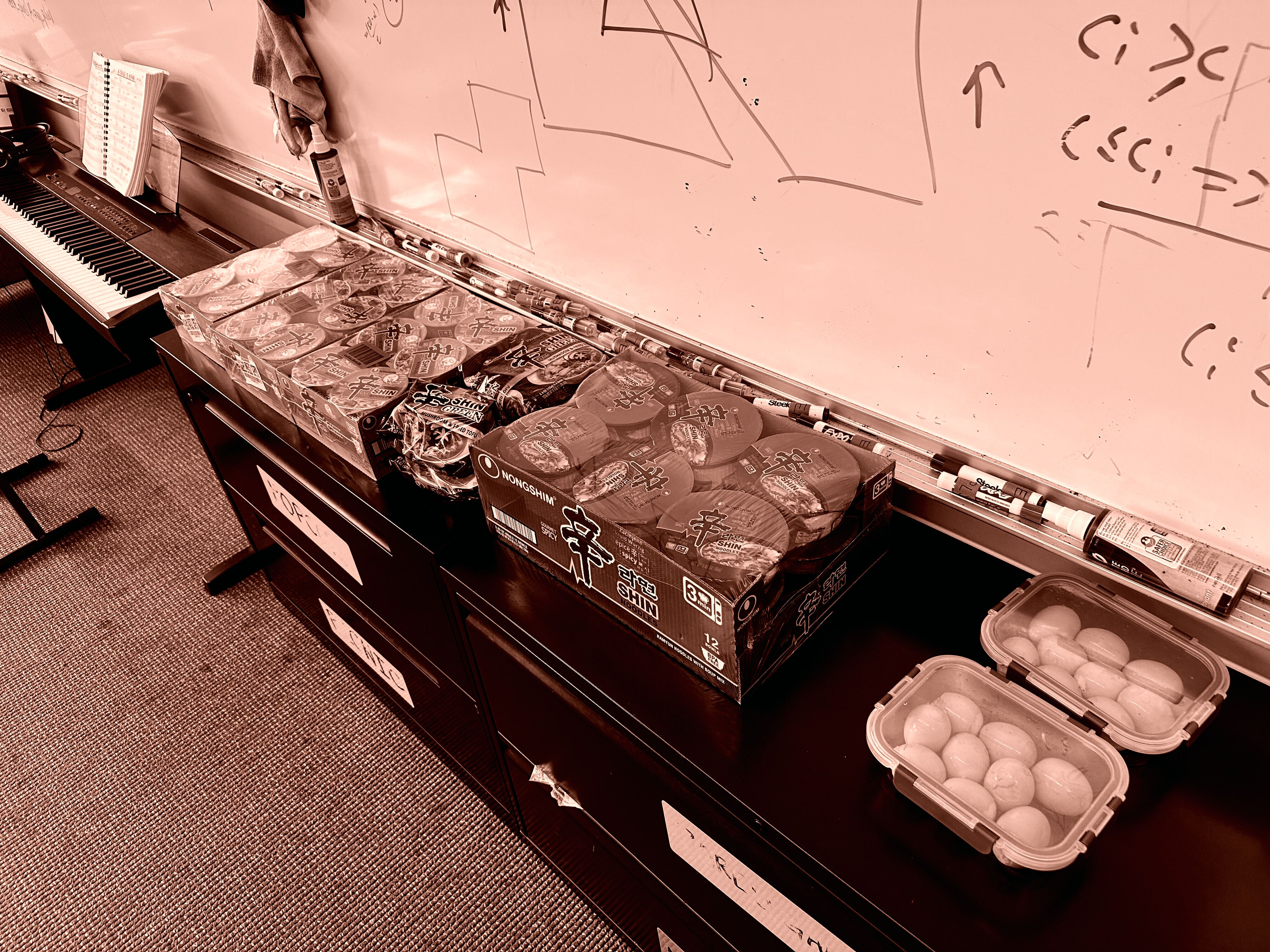
And if that wasn’t enough, he brought in ramen eggs. If you haven’t had ramen eggs, you’re missing out on a culinary delight. Ramen eggs are perfectly soft-boiled, marinated in a mixture of spiced soy sauce imparting a veritable umami flavor bomb. Now, you might argue that with the current price of eggs, this wasn’t a very frugal lunch. You’d be right, we ate like royalty that day. Don’t worry, we made up for it in the following week’s lunch.
Week 2: Beans
Ingredients
- (32) Bush's Vegetarian Baked Beans (16oz)
- (36) P-51 can openers
We began to wonder what Zach meant when he mentioned he’d bought “32 cans of baked beans and 36 can openers.” It turns out that there was really no need to wonder, because Zach had bought 32 cans of baked beans and 36 can openers. There was one hiccup, though. We had no idea how to operate a U.S. Army P-51 can opener. We grew up soft and coddled in the decadence of the 21st century, where convenience in the form of “easy open” ring-pull cans and electric can-openers had negated the need for us to learn crucial life skills like how to hand-churn butter or replace incandescent lightbulbs.
Zach took it upon himself to create a teachable moment for us by recording a helpful tutorial in the correct use of a P-51 can opener. Armed with this new, critical life skill, we made quick work of the cans that held our sweet, sweet prize; Bush’s Vegetarian Baked Beans (not sponsored)3. And by “sweet” prize, many of us quickly realized that a serving of baked beans had 11g of added sugar. But that was okay, right? A can of baked beans was surely a single serving.
WRONG! Those of us literate in nutrition labels found that each can of baked beans comprised 3.5 servings, meaning those who had an entire can (who eats half a can of beans?) consumed a whopping 38.5g of sugar. For context, that’s about the same as 10 sugar cubes, or how much sugar is in a can of Coca-Cola.
Week 3: Pemmican, Rubaloo, and Hardtack
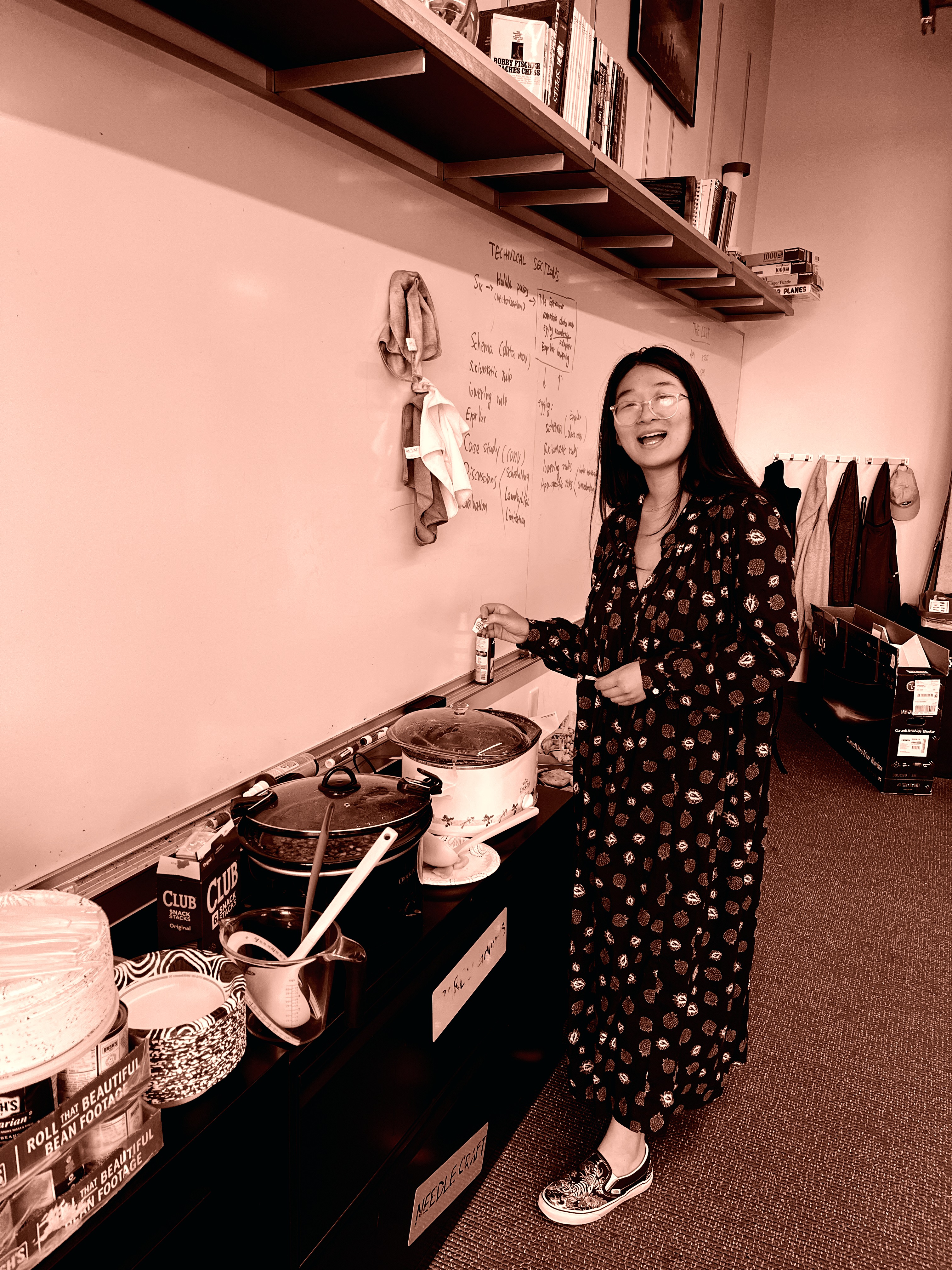
We took a trip back in time in week 3, when Amy painstakingly recreated what graduate students in the Colonial period would have had to eat; pemmican, rubaloo, and hardtack. You’ve probably heard of hardtack, the hardy, nearly unbreakable cracker which fueled long sea voyages, military expeditions, and graduate students at the Paul G. Allen School of Computer Science & Engineering during austerity lunches.
What you probably haven’t heard is the sound of teeth gnawing against it. Dentists in the Seattle Metro Area rejoiced. Many of us were surprised by how indestructible the hardtack was. This hardtack was freshly baked! I shudder to think how much harder it would become over time.
Amy,
of course,
thought of everything,
even a way to soften the hardtack for our delicate,
coddled palates.
She’d also prepared pemmican,
and rubaloo.
Not only that,
she’d also prepared vegan pemmican,
so nobody could escape all could partake in the culinary delights of
Colonial-period survival food.
Rubaloo proved to be the perfect way to transmute hardtack from solid granite
to a palatable Ritz-cracker like consistency.
The vegan pemmican was a crowd-pleasing favourite.
To everybody’s surprise,
we even had some hardtack left over,
which was quickly squirreled away in a tin to begin the aging process like a
fine wine.
Week 4: Peanut Butter and Jelly Sandwiches
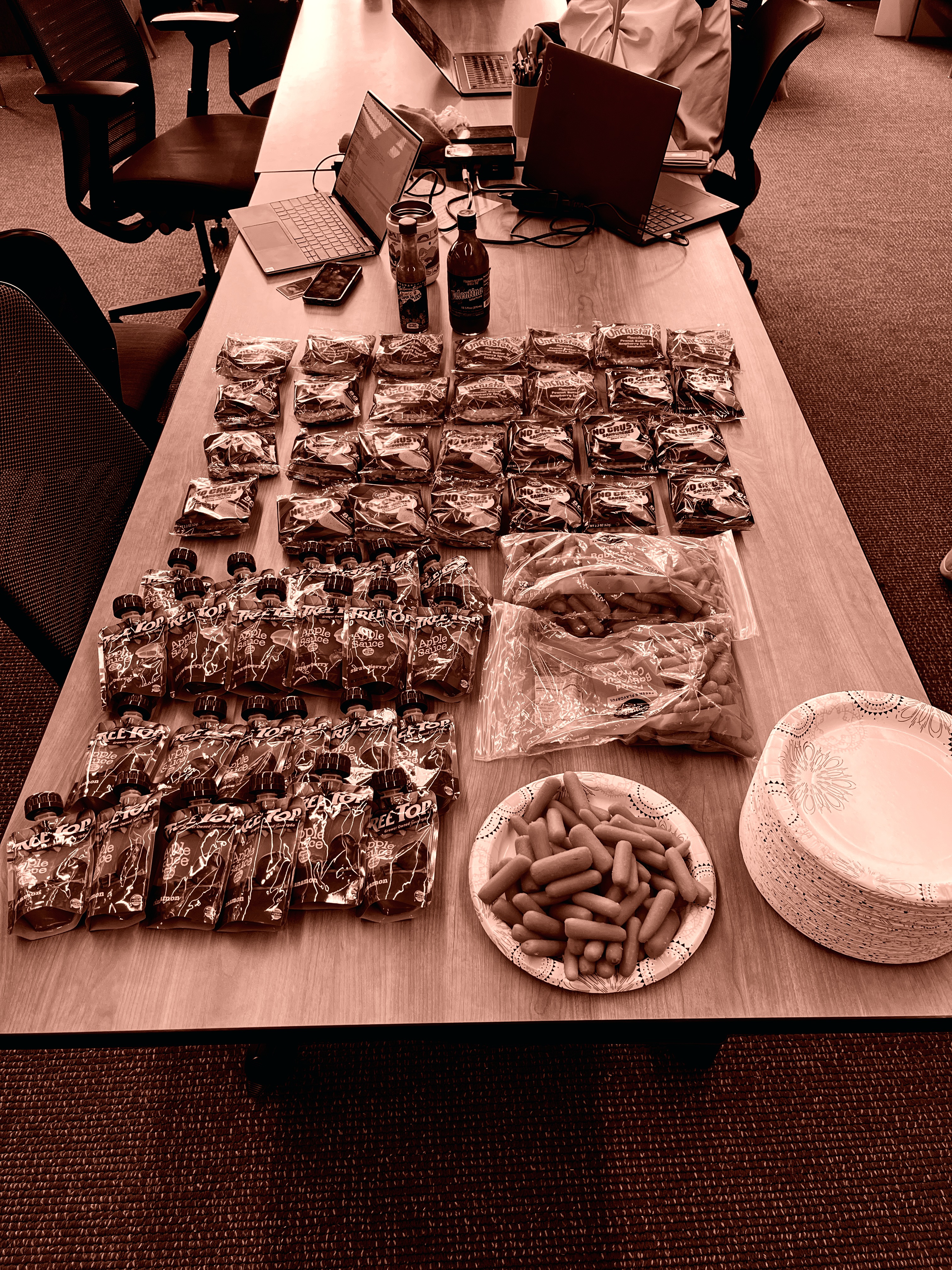
Ingredients
- (1) Jar of peanut butter, (36oz)
- (24) Applesauce packets
- A few bags of carrot sticks
- As many loaves of bread as you need for your group
According to a 2002 study commissioned by the J.M. Smucker Company (totally unbiased/not a leading nationwide producer of peanut butter), the average American will have consumed somewhere in the neighbourhood of 1,500 peanut butter and jelly (henceforth referred to as a “pb&j”) sandwiches before graduating from high school. More recently, the National Peanut Board–another impartial source–reported census data from the USDA and the U.S. Census Bureau showing that per capita consumption of peanut butter soared to an unprecedented 4.4lb in 2023.
It’s clear that Americans have a love affair with peanut butter4.
Why?
Perhaps the pb&j harkens back to simpler times; maybe it was the first meal a latchkey kid learned how to make; bread, peanut butter, jelly, bread. Easy. Maybe its versatility and ability to shine even in unexpected combinations is key to its success; peanut-butter noodles, peanut butter-miso cookies.
Peanut butter is an ideal foodstuff for grad students who want to stretch their dollar even further. It’s cheap, calorically-dense, doesn’t need refrigeration, and, perhaps most importantly, absolutely delicious. And, there’s no wrong way to enjoy it. In a sandwich, stirred into a stew, or even by the spoonful.
The pb&j austerity lunch was a big hit, featuring childhood favourites like applesauce, carrot sticks, and uncrustables. The more adventurous of us pushed the boundaries of good taste by combining hot sauce with peanut butter. They said it was delicious, I believe them.
Week 5: Potatoes
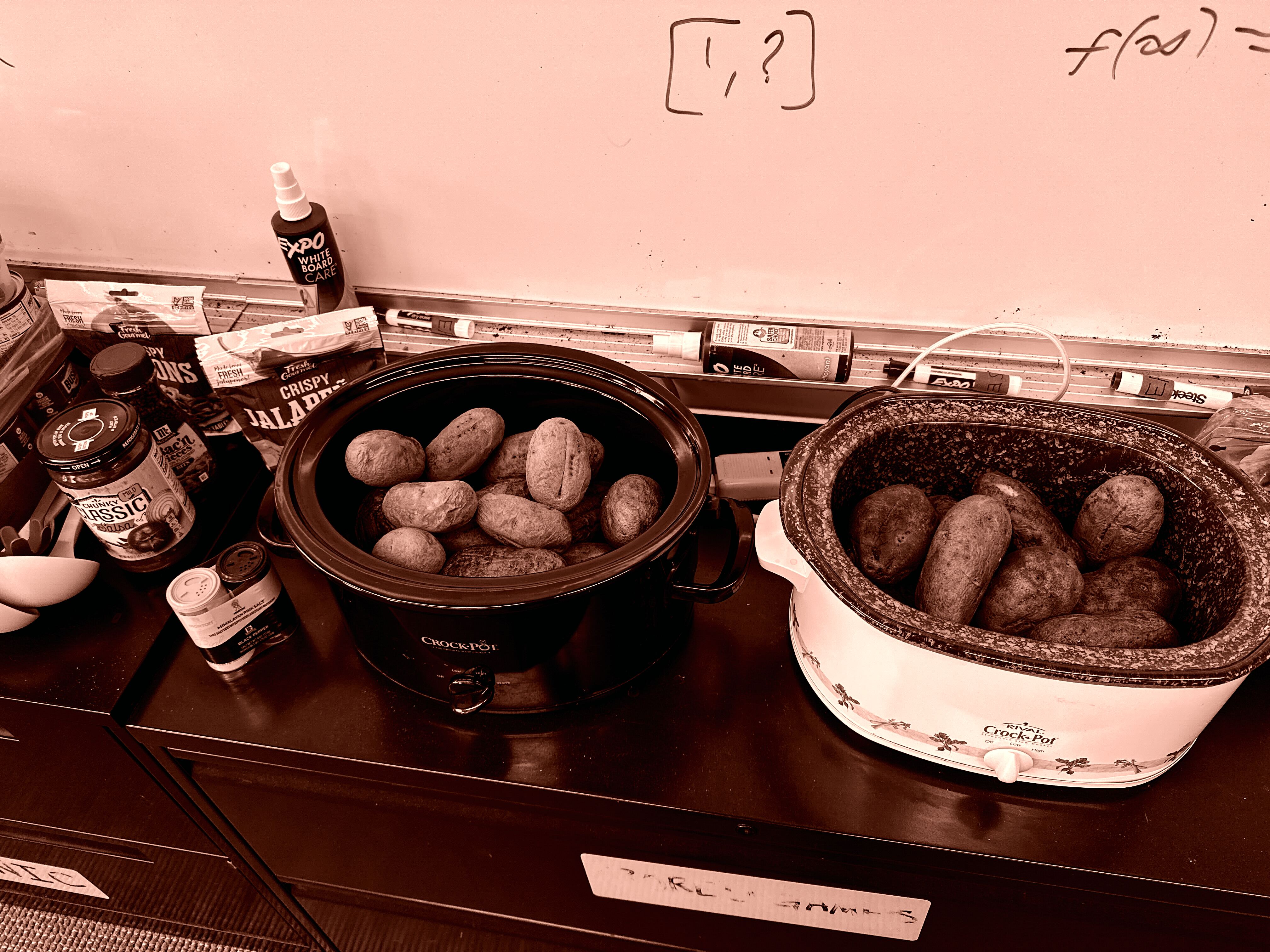
Ingredients
- 16-24 russet potatoes (baked in oven or microwaved)
- Any variety of toppings, such as:
- salsa
- sour cream
- shredded cheese
- scallions
- "bacon" bits
- Hot sauce(s)
Yours truly had a role to play in all this. Anyone who’s spent any time in the lab knows me as a creature of habit. I’m pretty happy to eat the same lunch 5 days a week (beans, beans, beans!), and you’ll rarely find me without a carbohydrate, whether that’s a sweet potato or a russet. I decided to share my love of carbohydrate with the lab in my austerity lunch contribution with a baked potato bar.
All you really need is as many russet potatoes as there are people you need to feed. Heat an oven to 400F. While your oven preheats, you can tackle the most complicated part of the recipe. Thoroughly clean each russet potato (they can be a little dusty), and pat them dry, after which you can rub them with a little olive oil and sprinkle some salt over them. This is going to ensure you get a relatively crisp skin out of the oven. Throw them in the oven and bake them until a fork meets no resistance. That’s it! You’ve got the perfect baked potato, a perfect nugget of resistant starch that really needs no embellishment.
Sure, you can add toppings like salsa, sour cream, or cheese, but why would you? The humble potato is perfect on its own.
Week 6: Chili & Cornbread
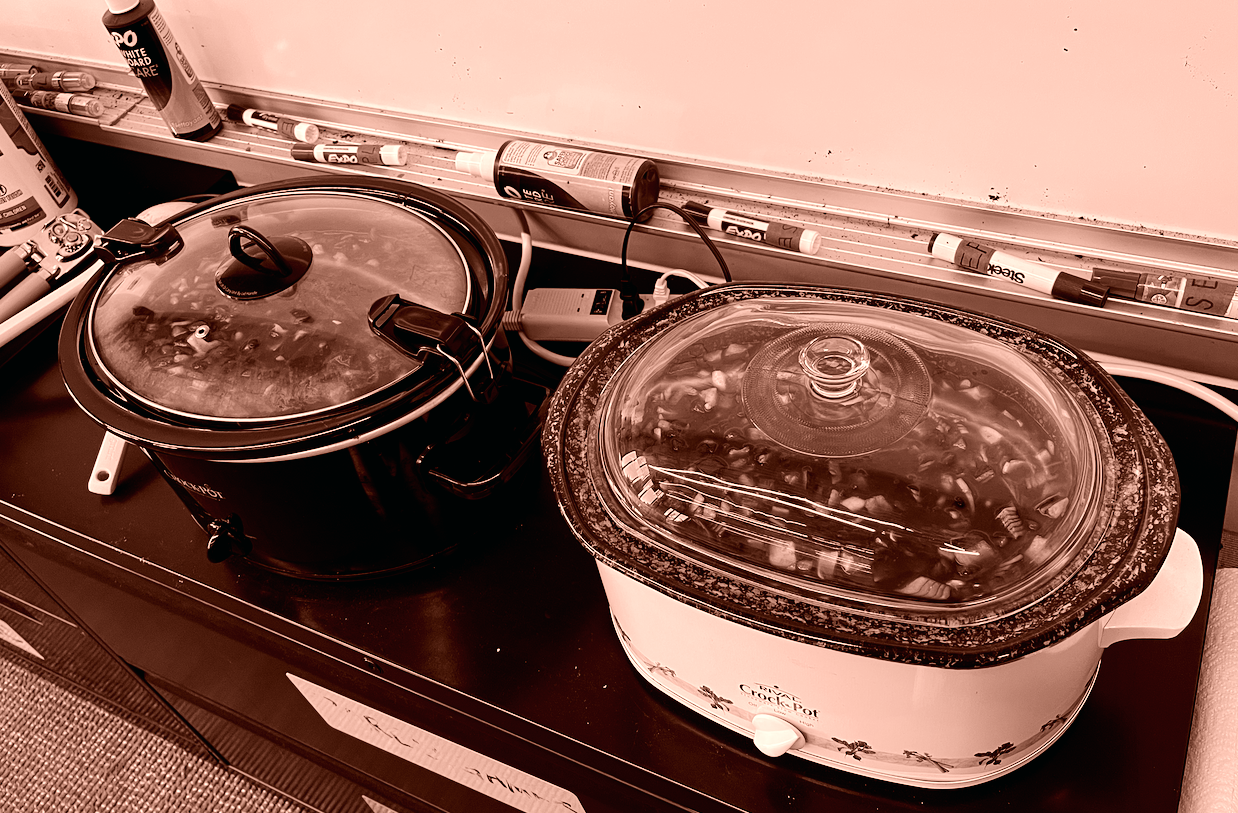
Ingredients
- A couple of red onions
- A couple cans of beans (kidney, black, etc.)
- Some corn
- Crushed tomatoes (or marinara sauce)
We had chili and cornbread in week 6. The chili was prepared by Zach, and the vegan cornbread was prepared by Anjali. Both were a big hit. The entire lab was overjoyed by the re-discovery of flavour after the baked potatoes of the previous week. The leftover sides from the baked potato bar (e.g., dried jalapeño, bacon bits) found new life in the chili, and the cornbread went fast; a perfect sweet compliment to the savoury chili. Ingredients from previous austerity lunches also made an appearance: hardtack returned as a vehicle for scooping chili, and leftover potatoes were microwaved as piping-hot sides.
Week 7: “Meatball” Sub Sandwiches
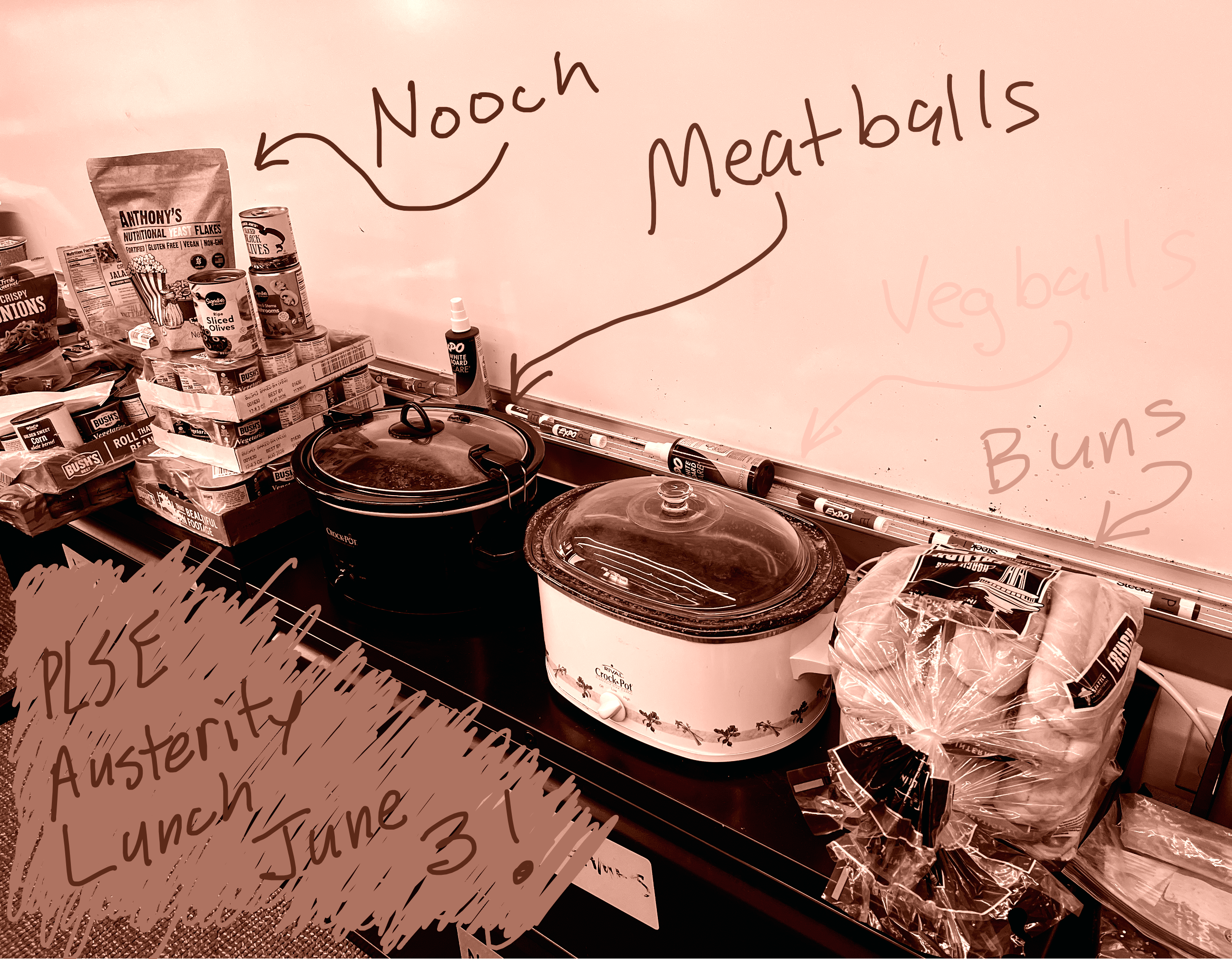
Ingredients
- Vegan meatballs
- Non-vegan meatballs
- Marinara sauce
- Nutritional yeast (nooch!)
- Buns and rolls
Back when you could actually get a footlong5 at Subway for $5, a meatball sub was how I filled up with 12 whole inches (sometimes all at once, other times, wisely split across two meals or so). I have to say, however, that Zach’s meatball subs blew anything I ever had at Subway straight out of the water. It might also be the recipe with the highest effort-to-enjoyment ratio. All you really need to do is get a couple jars of marinara sauce, some meatballs (vegan or meat, up to you), and throw it all in a slow cooker. In a couple hours, you will be rewarded with a filling lunch you can enjoy over a bread roll or (in my case) leftover potatoes! The best part is, everything will end up smelling like a Subway restaurant! Who needs “sandwich artists” when you’ve got a slow cooker.
Week 8: Pasta Salad
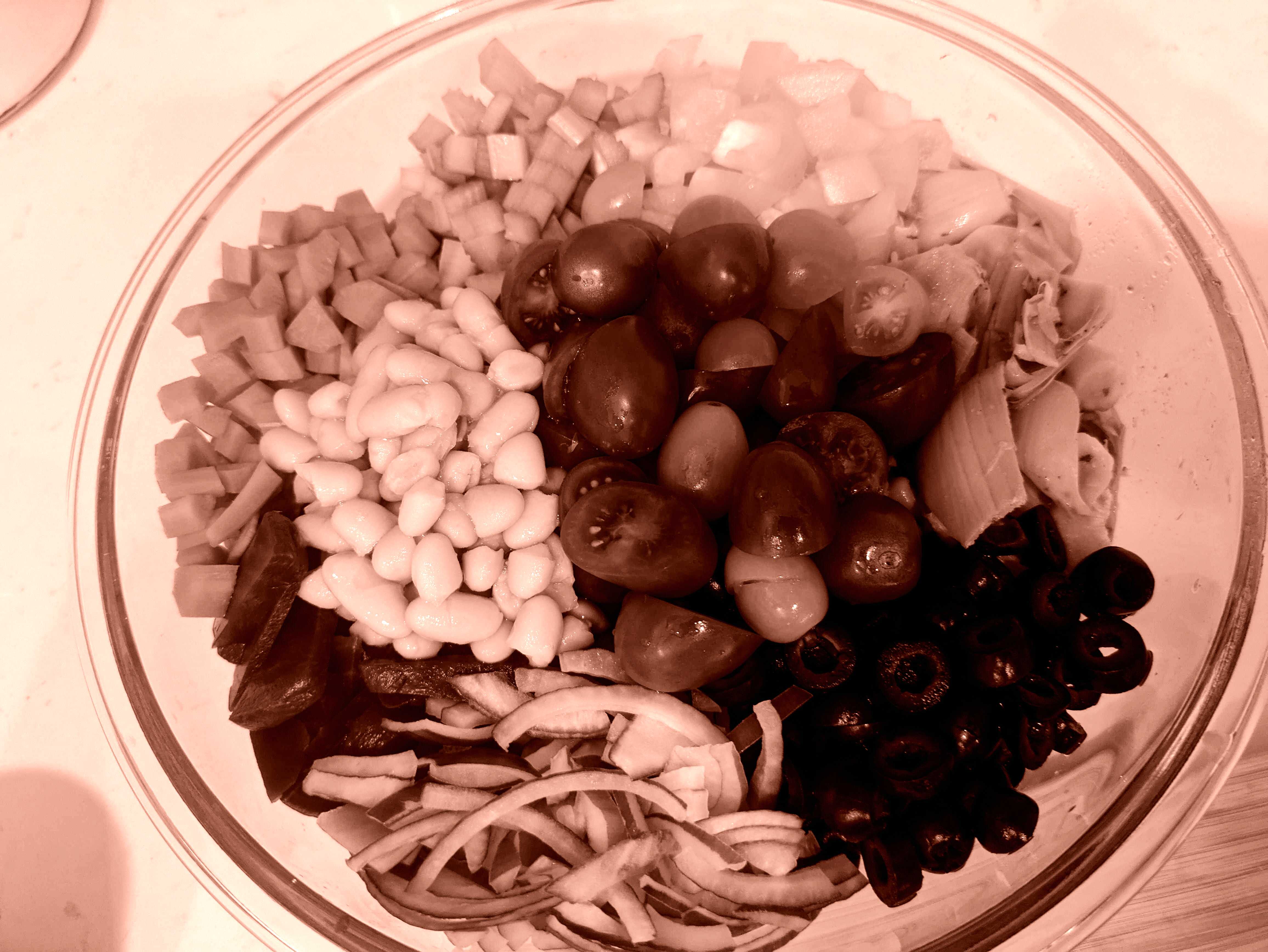
Ingredients
For the dressing
- Olive oil
- Red wine vinegar
- Oregano and Parsley
- Salt and black pepper
- Lemon
For the pasta salad
- Chickpeas
- Cannellini beans
- Red onion
- Black olives
- Artichokes
- Carrots
- Yellow bell pepper
- Farfalle
- Tricolori rotini
- Whole wheat rotini
Ryan brought in some delicious pasta salad to cap off a quarter of austerity lunches. If you haven’t had any of Ryan’s pasta salads, I’m sorry to say you’re missing out. The ingredients for a pasta salad can vary wildly. For instance, a “fancy” pasta salad might comprise ingredients you’d see in a high-end restaurant: heirloom beans cooked from dry, a very specific olive varietal from a very specific area of Europe, etc etc. I’m here to tell you that you don’t need fancy ingredients for a pasta salad.
Actually, what even is a salad? The image my mind conjures up when I think “salad” is just a bowl of greens, but the Wikipedia article states that a salad “is a dish consisting of mixed ingredients, frequently vegetables” That is an extremely broad definition, but a very effective catch-all. Under the definition of a “dish consisting of mixed ingredients,” things like ambrosia are also salads, as are potato salads, aspic, and the eponymous pasta salad being discussed right now. However, as someone in PLSE, I feel like this definition leaves much to be desired. I feel like there must be some way to delineate between, say, a pasta salad or a green salad or a potato salad. Here’s what I came up with:
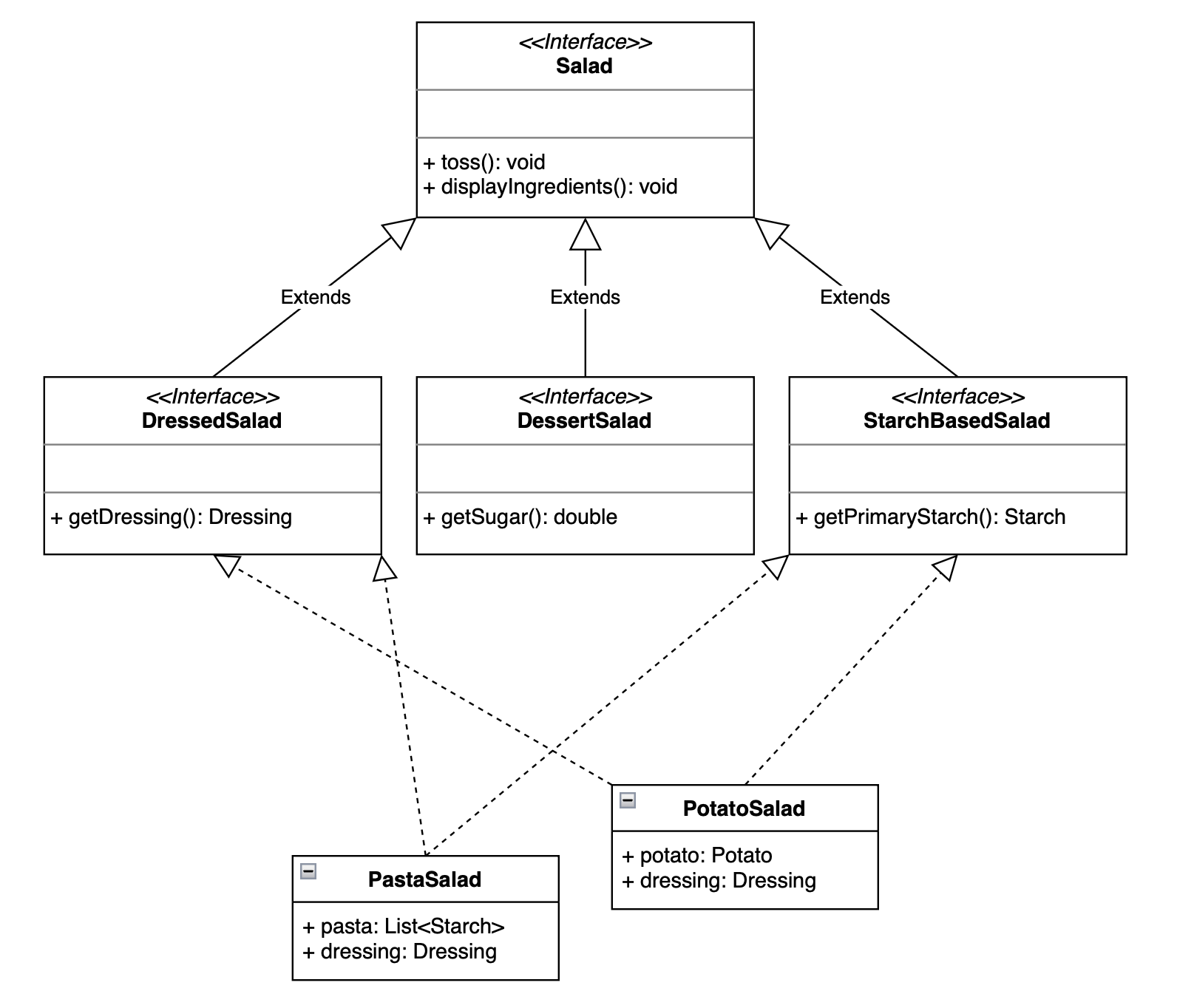
Great, we can now proceed with the rest of this blog post on solid theoretical grounding. Phew.
Ryan’s pasta salad is an exemplar of the fact that sometimes, the whole is greater than the sum of the parts.
Each ingredient is humble by itself, and frankly, struggles at times to stand alone–would you be satisfied eating a red onion by itself with nothing else? However, when you orchestrate these humble ingredients, combining them and enabling them to reach their peak potential of flavor, something truly extraordinary happens. Maybe that’s what this entire thing has all been about. At PLSE, we’re all ingredients in this crazy pasta salad.
If there’s anything this period of austerity has taught us, it’s that we’re better together.
Acknowledgements
Thank you to all the folks in the lab who stepped up to make PLSE austerity lunches a reality. We really do work best when we’re not hungry. Special thanks to Oliver for his helpful feedback on this blog post!
Further reading
See a response to this blog post.
-
If you’re a grad student and you don’t keep a supply of potatoes in your cabinet, ready to be microwaved in a pinch, you’re doing academia wrong. ↩
-
Or two hungry grad students ↩
-
But hey, if you’re someone at Bush’s Beans and you’re reading this, let’s talk ↩
-
Unless you’re extremely allergic to peanuts or other nuts, then you probably don’t have a love affair with peanut butter ↩
-
A Subway foot is 11 inches, not 12. As a Canadian, I’m baffled by inches in general. It would be easier if the US converted to the metric system. ↩
